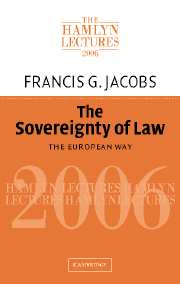Book contents
- Frontmatter
- Contents
- The Hamlyn Trust
- The Hamlyn Lectures
- Preface
- 1 Introduction
- 2 The rule of law in Europe
- 3 The European Convention on Human Rights and the rule of law
- 4 The European Union and the rule of law
- 5 Fundamental values
- 6 Courts and free markets
- 7 The European Union today: some achievements
- 8 The European Union today: some problems
- Afterword
- Index
4 - The European Union and the rule of law
Published online by Cambridge University Press: 29 July 2009
- Frontmatter
- Contents
- The Hamlyn Trust
- The Hamlyn Lectures
- Preface
- 1 Introduction
- 2 The rule of law in Europe
- 3 The European Convention on Human Rights and the rule of law
- 4 The European Union and the rule of law
- 5 Fundamental values
- 6 Courts and free markets
- 7 The European Union today: some achievements
- 8 The European Union today: some problems
- Afterword
- Index
Summary
The European Union is based on the rule of law to a far greater extent than any previous or contemporary international or transnational organization. The key to the notion of the rule of law is, as we have seen, the reviewability of decisions of public authorities by independent courts; the European Union goes far in recognizing this.
The European Communities – starting with the European Coal and Steel Community in 1950 – were created by law, in the shape of treaties, and endowed with a Court of Justice, whose function, stated in the broadest terms, was to ensure that the law was observed. Moreover, in contrast to other international and transnational courts, the jurisdiction of the European Court of Justice (ECJ) was not optional, but compulsory and automatic.
The ECJ was given a wide jurisdiction – the key to the effectiveness of the Treaties and to the observance of the rule of law.
Among its main functions was, and still is, to ensure the legality of the measures taken by the new institutions created by the Treaties, so that their considerable powers are exercised in accordance with the law. Specifically, the ECJ is to annul any measures where the institutions exceed or misuse their powers, or infringe other essential rules. In practice, any form of substantial wrongdoing, not necessarily requiring fault, is a sufficient ground for annulment.
- Type
- Chapter
- Information
- The Sovereignty of LawThe European Way, pp. 35 - 66Publisher: Cambridge University PressPrint publication year: 2007

